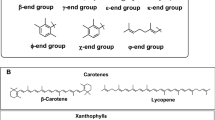Abstract
Astaxanthin and its esters, which are classified as secondary carotenoids, are synthesized under stress conditions in Haematococcus pluvialis cells that undergo transformation from vegetative cells to hematocysts. Stress factors can affect not only the rate and the direction of synthesis, but also the conformational changes in the pigment molecule, causing conversion of trans-isomers to cis-isomers. The aim of this study was to evaluate the effects of different factors (the polarity of the medium and light) on the process of trans–cis isomerization of astaxanthin. Investigation of the formation of 9-cis- and 13-cis-isomers from all-trans astaxanthin solutions at 50°C showed that medium polarity solvents stabilized cis-isomers more efficiently than highly polar solvents. Nonpolar solvents did not contribute to the stabilization of cis-isomers. The presence of π-bonds in the solvent molecule also stimulated isomerization. Analysis of the effects of the solvent refractive index on polarizability of astaxanthin revealed differences between the dependencies for polar and nonpolar solvents. Supposedly, solvents of medium polarity facilitate the process of trans–cis astaxanthin isomerization by decreasing the energy of the torque and stabilizing the cis-conformation of the molecule due to diminished dipole–dipole repulsion between the methyl groups in the polyene chain and the ionone ring. Exposure of astaxanthin solutions to light at 25°C induced formation of cis-isomers, which were more abundant within the first 4 h of exposure than after 6 h or later. Exposure to irradiation for longer periods caused astaxanthin decomposition and formation of degradation and oxidation products.











Similar content being viewed by others
REFERENCES
G. N. Coral-Hinostroza, T. Ytrestoyl, V. Ruyter, and V. Bjerkeng, Comp. Biochem. Physiol. C 139 (1–3), 99 (2004).
M. Osterlie, B. Bjerkeng, and S. Liaaen-Jensen, J. Nutrit. Biochem. 11 (10), 482 (2000).
Y. M. Naguib, J. Agricult. Food Chem. 48 (4), 1150 (2000).
M. Kobayashi, T. Kakizono, N. Nishio, et al., Appl. Microbiol. Biotechnol. 48 (3), 351 (1997).
X. Liu and T. Osawa, Biochem. Biophys. Res. Commun. 357 (1), 187 (2007).
J. P. Yuan and F. Chen, J. Agricult. Food Chem. 47 (9), 3656 (1999).
Food chemistry J. P. Yuan and F. Chen, Food Chem. 73 (2), 131 (2001).
J. Lerfall and S. Birkeland, Int. J. Food Sci. Tech. 49, 294 (2014).
S. Yang, Q. Zhou, L. Yang, et al., J. Oleo Sci. 64 (3), 243 (2015).
W. J. De Bruijn, Y. Weesepoel, J. P. Vincken, and H. Gruppen, Food Chem. 194, 1108 (2016).
Y. Weesepoel, H. Gruppen, W. de Bruijn, and J. P. Vincken, J. Agricult. Food Chem. 62 (42), 10254 (2014).
J. Milanowska and W. I. Gruszecki, J. Photochem. Photobiol. B 80 (3), 178 (2005).
L. Zhao, F. Chen, G. Zhao, et al., J. Agricult. Food Chem. 53 (24), 9620 (2005).
M. Buchwald and W. P. Jencks, Biochemistry 7 (2), 834 (1968).
N. G. Bakhshiev, O. P. Girin, and I. V. Piterskaya, Optika Spektrosk. 16 (5), 821 (1964).
I. Renge and E. Sild, J. Photochem. Photobiol. A 218 (1), 156 (2011).
G. G. Martinovich, L. A. Sazanov, and S. N. Cherenkevich, Cell Bioenergetics: Physicochemical and Molecular Bases (LENAND, Moscow, 2017) [in Russian].
M. R. Wasielewski and L. D. Kispert, Chem. Phys. Lett. 128 (3), 238 (1986).
M. J. Llansola-Portoles, A. A. Pascal, and B. Robert, J. Roy. Soc. Interface 14 (135), 20170504 (2017).
Funding
This work was supported by the Research Project of the Kurchatov Institute, Order no. 1363 of June 25, 2019.
Author information
Authors and Affiliations
Corresponding author
Ethics declarations
Conflict of interests. The authors declare that they have no conflict of interest.
Statement on the welfare of animals. This article does not contain any studies involving animals or human participants performed by any of the authors.
Additional information
Translated by D. Timchenko
Abbreviations: HPLC, high-performance liquid chromatography.
Rights and permissions
About this article
Cite this article
Kulikov, E.A., Kulikova, I.S., Vasilov, R.G. et al. The Effect of the Solvent Nature and Lighting on Isomerization and Oxidative Degradation of Astaxanthin. BIOPHYSICS 65, 433–442 (2020). https://doi.org/10.1134/S0006350920030112
Received:
Revised:
Accepted:
Published:
Issue Date:
DOI: https://doi.org/10.1134/S0006350920030112




